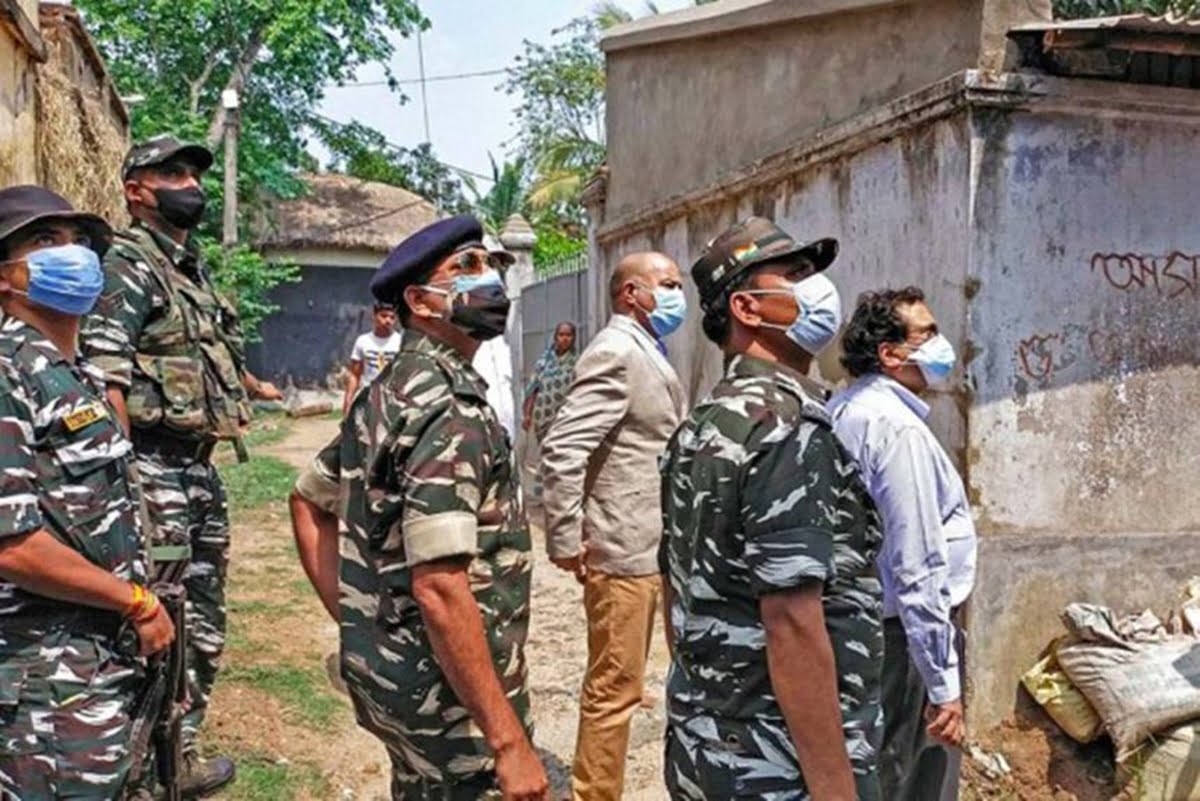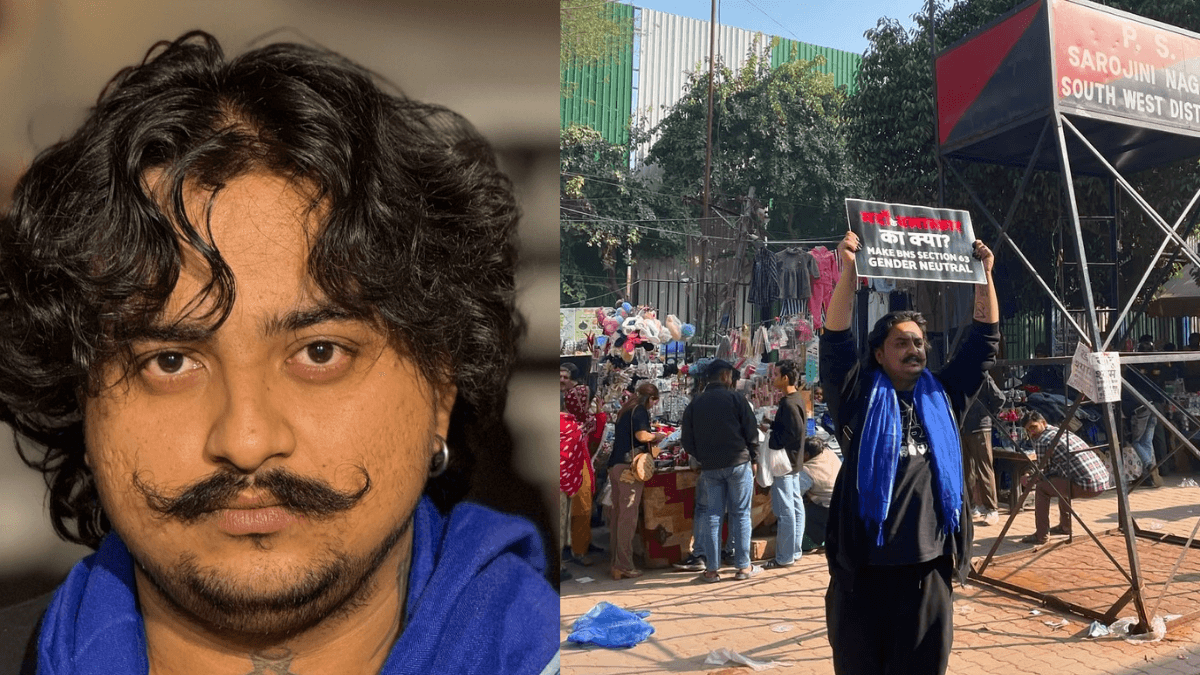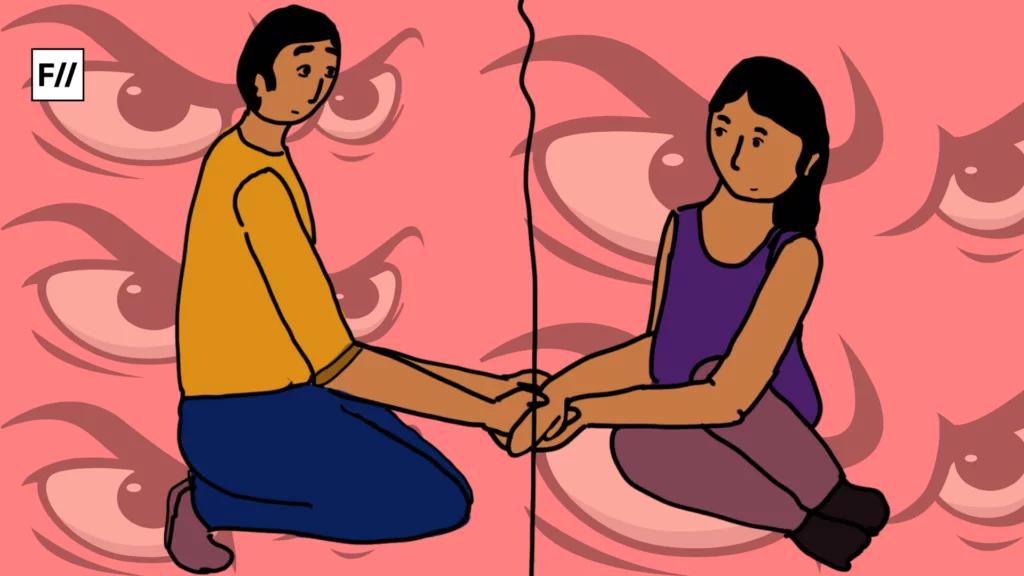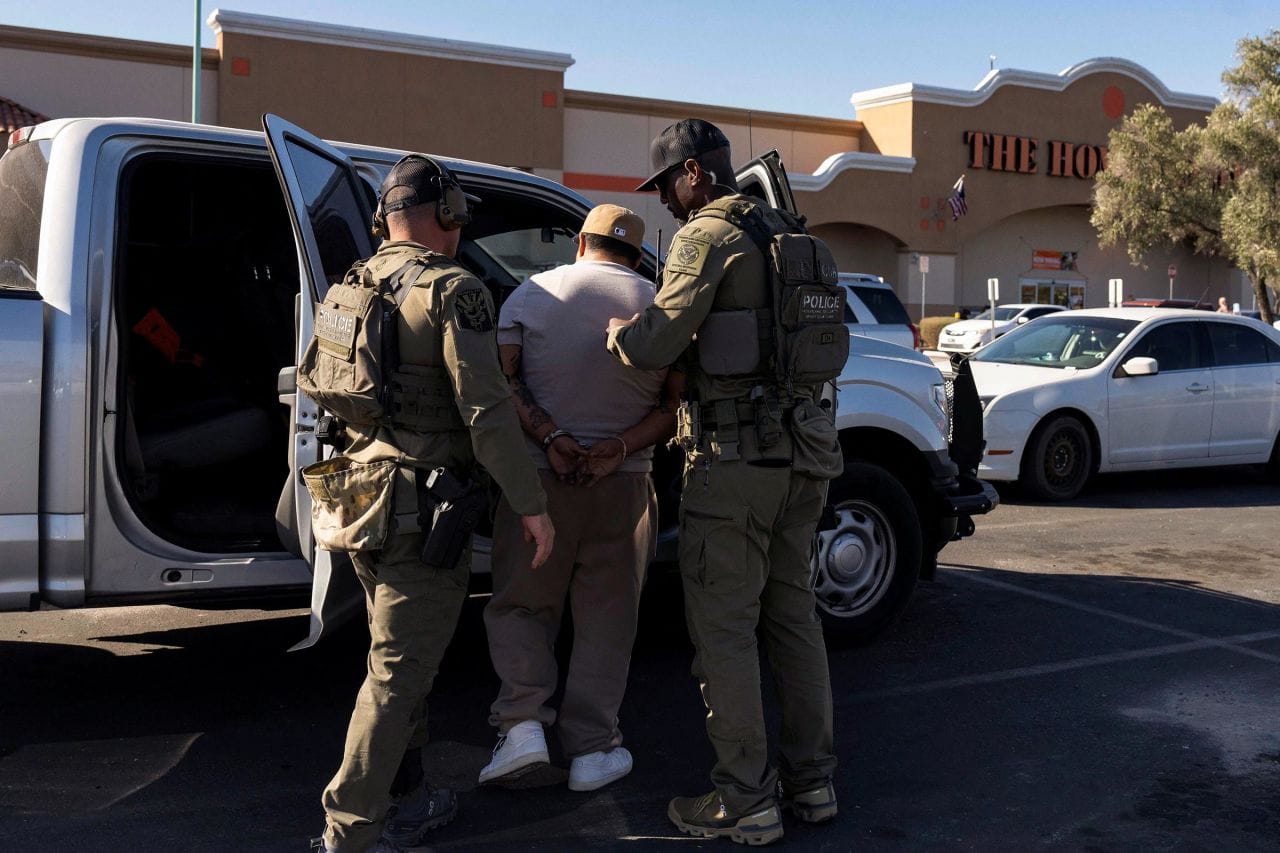That the connection between the masculine culture and violence perpetration is undeniable can be testified by the kind of speeches West Bengal BJP president Dilip Ghosh delivers. He not only promised to prove himself ‘not a coward’ by orphaning the children of opponents but also intimidated artists, intellectuals and civil society members by saying that he would smash them ‘if they dared to interfere in politics.’
So the dread of violence loomed large in West Bengal much before the poll results were out. Verbal violence was rampant during pre-election campaigning. While BJP roared ‘Bodol hobe, bodlao hobe’, (There will be change, there will be revenge as well), they referred to the violence perpetrated by Trinamool during Panchayat Elections, 2018, and pledged counter attack once they win. Eye for an eye turns the world blind and the present scenario of West Bengal bears testimony to it.
Masculinity is a set of norms applied by cultural consensus to biological men, as femininity is a set of norms applied by cultural consensus to biological women. Violence itself is, in many aspects, effective in gaining power and control, while power and control defines masculinity according to the cultural hegemony. So every tale of war, conquest and counter-conquest is often a violent one. It seems that applies to the electoral war as well.
Also read: Working With A Political Advocacy Group On The West Bengal Assembly Elections
Political violence in West Bengal has a history of more than fifty years. It is a state where ‘party’ occupying the public space replaces older forms of social organisations, such as family, land-ownership, caste and religion. Here, the feudal rule of pre-Independence era continued during the Congress regime. However, relentless movements followed, including Tebhaga Movement and Naxalbari movement and Food Riots led by the Communists. They challenged the feudal structure but were brutally suppressed, again by violence. When the Left Front came to power, it took significant measures like redistribution of land and a new panchayat raj, but the space left by the exit of the landlords was filled up by a new form of control: the party. The legacy of violence was carried on by party cadres and violence was unleashed in the last few years of the Left regime even to seize farm lands for factories.
Then Trinamool took over the sceptre and continued with the tradition of violence. As the BJP became the major contender in Bengal from 2019 onwards, it, too, adopted the violent nature and rhetoric quite expectedly, as it is the party that rules the entire nation with much hostility.
This time, right after Trinamool Congress swept the state by winning 213 of the 292 seats, reports of post-poll violence started coming in from various parts of the state. TMC supporters vandalised homes, shops of BJP workers and CPIM men in various districts, while BJP attacked the TMC workers and even a defeated TMC candidate. In Purba Bardhaman district, at least four people (allegedly three men from TMC and a woman from BJP) were killed in clashes.
This time, right after Trinamool Congress swept the state by winning 213 of the 292 seats, reports of post-poll violence started coming in from various parts of the state. TMC supporters vandalised homes, shops of BJP workers and CPIM men in various districts, while BJP attacked the TMC workers and even a defeated TMC candidate. In Purba Bardhaman district, at least four people (allegedly three men from TMC and a woman from BJP) were killed in clashes.
In Hooghly’s Khanakul, a TMC worker Debu Pramanik was hacked to death. In Kolkata, a BJP worker died after he was severely assaulted by TMC workers in Kankurgachi area late on Sunday night. There were reports of the killing of an ISF supporter at in North 24 Parganas. And the list goes on.
However, inter party conflicts also occurred amidst the eight phases of election, with recurrent news of the cadres of both TMC and BJP attacking each other. On the fourth polling day, four people were shot dead by the military forced in Sitalkuchi in North Bengal. The entire state revolted against the brutal killing, but BJP supremos openly stated that more people should have been killed. The post poll violence is a continuation of all these incidents.
In the past few years gender has entered the equation of understanding different forms of violence, may it be homicide, war, suicide or gender-violence. Men are the predominant users of violence not only against women but also against each other. Seeds of violence are ingrained in the patriarchal ideas and norms, and socialisation about manhood. Following this hegemony, the BJP never shies off declaring its hypermasculine aggression. But on the other hand, even if the chief minister of West Bengal is a woman, her supporters seem to have inherited the same machismo. Amidst all these developments, the BJP has been using social media to create a different narrative by spreading fake news and giving the violence a communal colour. Swapan Dasgupta, former BJP Rajya Sabha MP, tweeted on Monday that molestation and murders are taking place in Nanoor and Amit Shah should send military force.
But it was found to be fake news later and Kangana Ranaut was suspended by Twitter for sharing it and invoking violence. Saumitra Khan, BJP MP from Bishnupur tweeted that a BJP woman worker in Nanoor, Birbhum was gangraped, but later deleted it. But versions of it was circulated by other supporters which were declared fake by the CID and West Bengal Police.
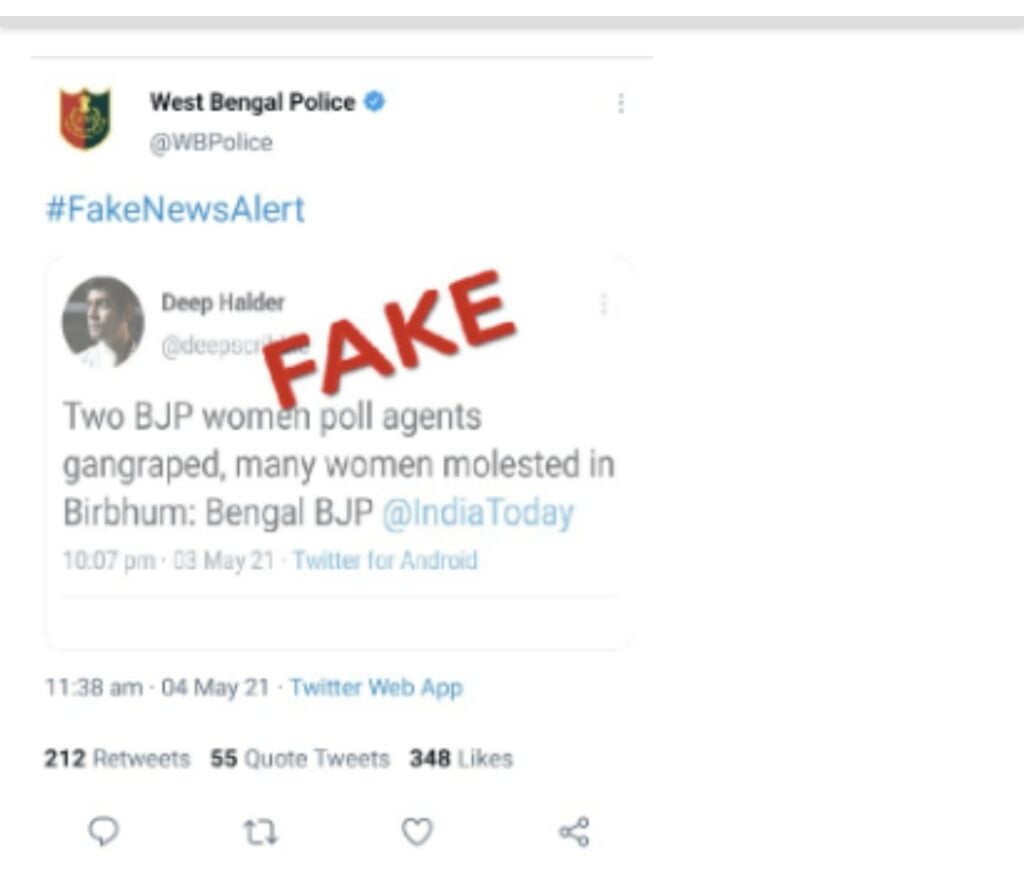
Senior journalist Abhijit Majumder also amplified the communal angle. But, Nagendra Nath Tripathi, Birbhum police chief, confirmed in a press meet that reports of gang-rape in Birbhum are fake.
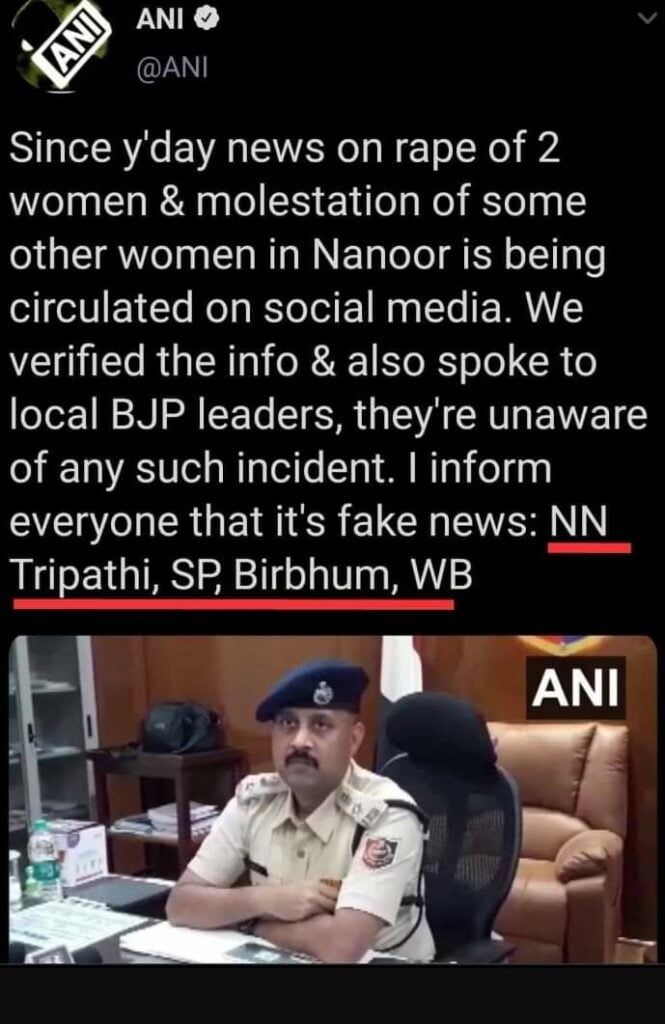
An old video of a mob attacking police in Odisha was wrongly shared as evidence of post-poll violence in West Bengal, AltNews reported. A photograph from the 2019 Vidyasagar college violence was also passed off as post-poll violence.
Also read: Looking At Bengal Assembly Elections Through The Glasses Of The ‘Other’
An old video of a mob attacking police in Odisha was wrongly shared as evidence of post-poll violence in West Bengal, AltNews reported. A photograph from the 2019 Vidyasagar college violence was also passed off as post-poll violence.
Another picture of mob violence with the hashtag #BengalBurning was widely shared. However, AltNews fact-checked and found the image as belonging to a report by The Hindustan Times from March 2018, with the image credited to PTI.
Even the Communist Party of India (Marxist) – itself a victim of the violence – stepped in to declare that all the news and videos and pictures should be checked before being spread.
While toxic masculinity certainly has its hand in the perpetration of violence by both the parties, the circulation of false narratives of rape and genocide by the BJP, too, cannot be explained without mentioning a gender identity crisis. The hypermasculine Hindutva politics of Hindu men expect them to be the self-appointed gatekeepers of the their women’s honour and rescue the Hindu mother-sisters from the ‘otherised’ Muslim rapists and molesters. For that matter, according to the narrative, the entire Hindu clan is to be saved from the Muslim invaders. The BJP has always utilised the Hindu man’s imaginary crisis of being ‘less of a man than a Muslim’ and thereby helped the toxic Hindu masculinity to flourish. Anxiety over masculinity is foundational to the Hindutva movement. In ‘Sexuality, Obscenity, Community: Women, Muslims, and the Hindu Public in Colonial India’, Charu Gupta writes about the Hindu-Muslim riots of the 1920s: “For militant Hindu organisations, a show of physical strength was their psychological defense, their reply to the images of the powerful, rational British and the lustful Muslim.“
The same stratagem is at play here. Viswa Hindu Parishad issued a statement saying: “Hindu society also has the full right of self defence, which it will use.”
All these developments took place at a time when the new government was yet to be sworn in and the state was technically under the Governor’s rule. The new government was formed on 5 May. In the meantime, petitions were submitted in the Supreme Court calling for presidential rule which means overturning the elected government and giving the military force a free hand, which eventually is beneficiary for BJP only.
The Bengal post-poll violence may not be one-sided or new. But the CM has a duty to stop it as soon as possible. Merely a plea for peace is not enough. The government should not give the BJP a chance to fuel communalism. On the other hand, the civil society members should condemn (and they already have condemned) the bloodbath, in which at least two of the parties were involved and supporters of at least five parties (TMC, BJP, ISF, CPIM, Congress) fell victim. They must oppose violence as a whole as it finally makes victorious the hypermasculine, toxic culture of aggression that they have always been fighting against, no matter whoever is there in power.
Featured image source: Outlook India
About the author(s)
Satabdi Das is an activist, author, teacher. She is the editor of Khader Dhare Ghor (A House By The Canyon: A book on Domestic Violence), has authored Naribadi Chithi O Onyanyo (Feminist Letters and Others) and O-Nandonik Golpo-Sonkolon (The Unaesthetic Stories). Her areas of work are domestic violence, sexual violence and inequalities in school-curricullum. She can be found on Facebook and Twitter.
